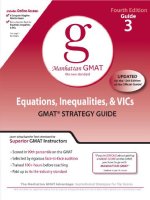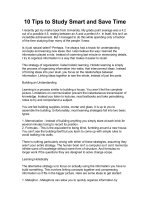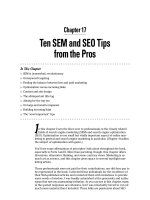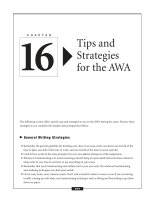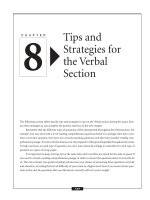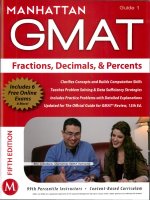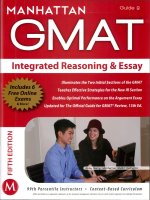GMAT essay and AWA tips
Bạn đang xem bản rút gọn của tài liệu. Xem và tải ngay bản đầy đủ của tài liệu tại đây (55.33 KB, 4 trang )
GMAT Essay and AWA Tips
Top Essay & AWA Tips for the GMAT
1. Be sure to include brief introductory and concluding paragraphs, which are consistent with each
other and with the paragraphs in the body of your essay.
2. Your essay must at least appear to be well organized. Use transition words and phrases to help
the reader follow the flow of your discussion. For ideas, check out the transitional devices I've used
in my sample Issue essays and sample Argument essays.
3. Compose your introductory paragraph last after you've completed the rest of your essay. Why?
Because you essay might evolve somewhat from your initial plan; if you've composed your
introduction first, you might need to rewrite it.
4. For every point you make in a GMAT essay, always provide a reason and/or an example to
support that point!
5. Pay close attention to writing mechanics, grammar, sentence construction, word usage and
diction (whether you've used the right word for the right job). It doesn't matter if your essay contains
brilliant ideas if you can't express them. In short: It's form over substance!!
6. It's okay to refer to yourself in your essays at your option. Just don't overdo it. Phrases such as "I
think," "it is my opinion that" and "in my view" are superfluous and a waste of your typing time.
7. Don't try to impress the reader with your vocabulary. There's nothing wrong with demonstrating a
strong vocabulary. Just don't overdo it; otherwise the readers will suspect that you're using big
words as a smokescreen for poor content.
GMAT Tips . Analysis of an Issue
Spend at least 3-4 minutes jotting down some points both for and against the statement. In support
of every point try to think of at least one reason or example.
Go for breadth, not depth. Try to cover both polar sides of the issue, and various arguments on
both sides. Don't dwell on one point! (This is the #1 essay blunder committed by GMAT test-takers.)
But don't try to cover everything either; otherwise, you might not have time to develop each of your
ideas with reasons and examples.
Begin your Issue essay by acknowledging the complexity of the issue and by adopting a position on
it.
Do NOT begin your Issue essay by restating or paraphrasing the statement. (This blunder will wave
a "red flag" to the GMAT readers who will assume from the outset that you lack ideas of your own.)
Don't waste time thinking about what position on the issue you should adopt or what position a
GMAT reader would want you to adopt. The readers don't care about your opinions; what they do
care about is how persuasively you support your position with relevant reasons and examples, and
how effectively you communicate your ideas.
Your final paragraph should contain no more than two sentences, and should recapitulate (sum up)
your argument reiterating where you stand on the issue "in the final analysis," and why. Don't
introduce any new examples, reasons, or ideas in your summary paragraph.
Analysis of an Issue
(1 Question 30 Minutes)
"The media today place too much emphasis on provocative images, and not enough emphasis on
the ideas and events behind those images."
To what extent do you agree or disagree with the foregoing statement? Use reasons and/or
examples from your experience, observation, and/or reading to explain your viewpoint.
Below is a sample response to this question. As you read the response, keep in mind: This
response meets all the official criteria for a score of 6 (the highest possible score). This response is
by no means the correct one. (As the official directions state: "There is no correct response.") So
don't worry if, in your response, you adopted an entirely different position on the issue, or if you
used entirely different examples and reasons to support that position.
I didn't compose this response under timed conditions; so don't worry if yours isn't as lengthy or as
polished. Take comfort: You can attain a top score of 6 with a briefer and less-polished essay.
Sample Response (540 Words)
Upon first glance at today's media whether broadcast or print it would appear that the speaker is
correct. However, in my view the media's emphasis on image is largely justifiable. Moreover, the
speaker understates the extent to which the media also covers the substance behind those images,
as discussed below. I concede that the media today do place considerable emphasis on image.
Advertisements are increasingly resorting to fast-moving, sexy, images. In fact, advertisements
which provide no product information whatsoever not even about what the product looks like or
how it is to be used are becoming increasingly common. Also, while tabloid magazines and
television programs abound, intelligent discourse can be found sparingly only on public television
and a few other arts and education
Channels, and among the stacks of scholarly journals at our libraries and at obscure websites. And,
despite television's tremendous potential for airing the vital political issues of the day, the brief
sound bites from our self-conscious politicians today hardly meet that potential.
Whether this emphasis on image is justifiable, it is certainly understandable at least with respect to
advertising for two reasons. First, products are becoming more and more fungible these days;
consider automobiles, for instance. Since they vary little from one make to another today, marketers
are forced to resort to image for product differentiation. The second reason has to do with the fact
that we are becoming an increasingly busy society. In the U.S., for instance, the average workweek
is now over 65 hours, compared to 40 a generation ago. Meanwhile, the number of goods and
services competing for our attention seems to grow exponentially. Thus, how can the growing
number of businesses compete for our limited time except by resorting to attention-grabbing
images?
However understandable this focus on image, is it nevertheless unjustifiable, as the speaker
implies? Media critics point out that undue focus on appearances and images amounts to an appeal
to our emotions and our baser, prurient instincts rather than to our intellect and reason. Taken to
an extreme, argue the critics, such focus facilitates irrationality, and even sanctions demagoguery.
The result is that we dissuade ourselves as a society from engaging in the sort of informed debate
needed for any democracy to survive, let alone thrive. I might be convinced by the critics were the
media to withhold the substance underlying the images; but they do not. Behind most newspaper
headlines, magazine cover stories, and reputable Internet home pages is a wealth of substantive
content; we simply need to look for it.
In sum, although I wholeheartedly agree that the media should not sacrifice substance merely to get
our attention, the speaker overlooks that the substance is in fact there. Besides, without substance
the products, services, politicians, artists, authors, and others behind all those provocative images
eventual wither. Sexy cars that are proven unsafe are redesigned or discontinued; politicians who
don't follow through on promises are soon defeated; musicians who lack artistry and originality fade
into oblivion; and authors without important ideas eventually lose an audience. In the final analysis,
it is not the media's job to wave ideas and events in front of us; rather, it is up to us to look for them
behind the hoopla and the headlines.
. Here are some Quick Tips for tackling the GMAT "Argument" writing task:
Spend 4-5 minutes brainstorming and jotting down the logical problems you intend to identify and
discuss in your essay. Then number these problems from most serious to least serious. Present
them in that order in your essay.
Each argument in the official test bank contains 2-4 major logical fallacies or other logical problems.
(That's how the test-makers design them.) To score high you must identify and discuss each major
logical problem. Here are the ones that appear most frequently among the arguments in the official
test bank:
.
Generalizing from particulars (relying on a small number of particular cases too small to reach a
reliable general conclusion)
Confusing chronology with causation (because one event occurs after another, the earlier event
caused the later event)
Drawing an unfair analogy (ignoring relevant dissimilarities between two things when comparing
them)
Go for breadth, not depth. Try to cover every major logical problem with the argument. Don't dwell
on one point! (This is the #1 essay blunder committed by GMAT test-takers.) As a rule of thumb you
shouldn't devote more than 3 or 4 sentences to discussing any one point of your critique.
Avoid Intro-itis. Do NOT begin your essay by rehashing the argument that you intend to critique. A
brief introduction in which you indicate the thrust of the argument and that it is problematic for
several reasons will suffice. Your time is far better spent delving directly into your critique of the
argument. (Just as with the Issue essay, intro-itis will wave a "red flag" to the GMAT readers who will
assume from the outset that you lack ideas of your own.)
In addition to identifying each major logical problem with the argument, always discuss
.
what additional information is needed to better evaluate the argument, and/or
what additional evidence (facts) would serve to strengthen the argument.
.
Include these points in your essay's final paragraph.
Analysis of an Argument
(1 Question 30 Minutes)
The following appeared in a recent report by the Fern County planning commission:
"In light of the increasing percentage of our nation's population turning to the Internet as a source
of reference material, Fern County should close the ancillary branch of its public library, and
convert that facility into a computer training center for use by county residents. The converted
facility would fill what is certain to be a growing need among Fern residents for computer training. At
the same time, since the county library's main branch already contains more volumes per resident
than any other county library in the state, it will adequately serve the needs of Fern County
residents. Moreover, Fern residents are sure to support this plan; after all, in nearby Mesa County
only a few residents have objected to that county's plan to close all but one of its public libraries in
the near future."
Discuss how logically convincing you find this argument. In your discussion, you should analyze the
argument's line of reasoning and use of evidence. It may be appropriate in your critique to call into
question certain assumptions underlying the argument and/or to indicate what evidence might
weaken or strengthen the argument. It may also be appropriate to discuss how you would alter the
argument to make it more convincing and/or discuss what additional evidence, if any, would aid in
evaluating the argument.
.
Below is a sample response to this Argument. As you read the response, keep in mind : This
response meets all the official criteria for a score of 6 (the highest possible score). I didn't compose
this response under timed conditions, so don't worry if yours isn't as lengthy or as polished. Take
comfort: You can attain a top score of 6 with a briefer and less-polished essay.
Sample Response (550 Words)
In this argument the Fern County planning commission recommends converting a library into a
computer-training facility. However, the committee's recommendation rests on numerous unproven,
and dubious, assumptions about the impact of Internet access on libraries, about Fern County
residents, about the adequacy of the main library, and about Mesa County and its residents. As a
result, the committee's argument is unconvincing at best, as discussed below.
To begin with, the committee's argument rests on two unsubstantiated assumptions involving the
cited national trend in Internet usage. One such assumption is that increasing use of the Internet as
a reference source will necessarily result in decreased use, or demand, for public libraries. While
this might be the case, the commission must provide firm evidence to substantiate this assumption;
otherwise, it is equally plausible that the cited trend will actually enhance the popularity of libraries
by stimulating intellectual and cultural interest. A second such assumption is that Fern residents
reflect the national trend. The committee provides no substantiating evidence for this crucial
assumption; lacking such evidence, it is entirely possible that Fern residents have little interest for
whatever reason in using the Internet for this purpose, and therefore that the proposed plan is not
in their best interests.
Another problem with the argument involves the report's assertion that that there is certain to be a
growing need in Fern County for computer training. In context, this claim appears to be based on
the national trend in Internet usage. Yet even assuming Fern residents reflect this trend, it is
entirely possible that Fern residents as a group are already highly proficient in using computers and
the Internet. If so, Fern residents might very well prefer the status quo, and would not support the
proposed plan.
Yet another problem with the argument involves the fact that Fern County's main library boasts a
large number of books per resident. This fact alone is scant evidence that the main branch is
adequate to service county residents. The committee overlooks the possibility of a future influx of
county residents. The committee also ignores that the library's value lies not just in the quantity of
its books but also in the quality of its books. Thus without reliable demographic projections and
detailed information about
the main library's inventory vis-a-vis the needs of Fern's residents, the committee cannot convince
me that the main branch alone would serve the needs of county residents.
A final problem involves Mesa's plan to close all but one library. We are not informed whether Mesa
residents are yet aware of the County's plan. Even if the plan has been made public, the fact that it
has met little opposition does not necessarily mean that residents as a whole support the plan.
Perhaps Mesa residents as a group are not inclined to voice their opinions. Or perhaps as a group
they are far less concerned about library access for whatever reason than Fern residents are.
In sum, the argument is unconvincing as it stands. To strengthen it, rather than relying on a dubious
analogy between Fern and Mesa counties, the commission should provide better
evidence perhaps by way of a countywide survey that Fern residents will increasingly use the
Internet as a substitute for the ancillary library branch, and that they would benefit from a new
computer-training center.
